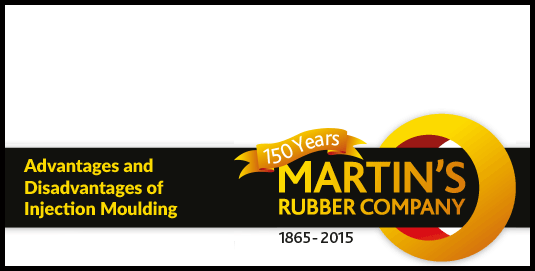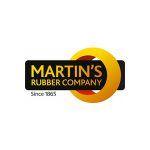Advantages of Injection Moulding and why it is the most efficient rubber moulding process
Within this article, Martin’s Rubber looks at the advantages of Injection moulding, demonstrating what the process entails and how producing an Injection mould can improve your overall process.

Martin’s Rubber has range of dedicated Injection moulding machines with up to 1 litre capacity and a clamp force of 220 tonnes. Injection moulding has been defined as ‘The Process of rapidly forcing an exact amount of rubber from a tube/cylinder into a closed, heated mould’.
History of injection moulding
Injection moulding’s origins date back to the early 1960s, where it was initially created as an extension of the plastics industry. After overcoming initial problems surrounding temperature (As you cool plastic during moulding, whereas rubber relies on heat) and pressure (since rubber injection moulding requires significantly more pressure per square inch of cavity surface), the process has become arguably the most efficient way to mould rubber in many situations.
The process of Injection moulding generally consists of producing parts by injecting material into a closed mould. This involves feeding the material for the part into a heated barrel, after which it is then mixed and forced into a mould cavity. Here, it cools and hardens to the shape of the cavity. After the product has been designed, moulds are designed to allow for de-moulding and shrinkage of the finished part, then formed out of metal (often steel or aluminium) and precision-machined to produce the features required of the part.
Where can injection moulding be performed?
Injection moulding can be performed with a variety of materials, including glasses, metals, elastomers, confections and, most commonly, thermosetting and thermoplastic polymers. This process can be used in various circumstances, particularly when producing: large shot weights, high volumes of small to medium size parts, incorporating bonded inserts, achieving close dimensional tolerances and making components that require uniformity or consistency of colour. Some examples of where Injection moulding components are used include: coloured instrument boots, O Rings, drive coupling assemblies and automotive parts.
Below we look at the advantages of injection moulding and how it can improve your rubber moulding processes vs the disadvantages.
What are the advantages of injection moulding?
- Lower unit costs - Injection mouldings often have a low production cost per unit, due to reduced cycle times and higher levels of automation.
- Faster cycle times - With Injection moulding, cycle times are approximately between 15-30 seconds for each cycle. This type of moulding can produce a vast amount of parts per hour depending on how many impressions are in your tool.
- High dimensional tolerances - Close tolerances on smaller, more intricate parts is possible when using the Injection moulding process. The greater level of automation also allows for a much higher degree of consistency of part.
- Low levels of flash - The injection press’ clamping force keeps the mould tightly sealed closed during the cycle, thus this leads to maintaining tighter tolerances and lower levels of flash. Since the process does not depend so much on overfilling the mould to make good parts, there is less variation across the split line of the part, and thus less flash.
- Little scrap/waste - If thermoplastic material is used in this process, excess material or scrap can be ground up and recycled so that it can be reused, rather than wasted. This is not always the case with thermoset materials, however.
- Reduced need for secondary trimming work - There is often very little secondary, post-production work needed due to the parts usually having a good finished look upon ejection.
What are the disadvantages?
- Higher set up costs - It can sometimes be quite costly to have a tool made for injection moulding. In order to feed the material into the tool, then demould the part once cured, the tooling required has more features such as runners and ejector systems, adding to initial costs. In addition, because of these features, it takes longer to set up an injection mould in a press and approve first off production, and thus cost can really build up when you need an injection moulding machine in addition to the skills to run it.
- Waste can be excessive - The necessity to feed material from the injection chamber into the mould cavities via a series of runners and feed gates can mean that a significant amount of rubber never gets used in an actual part. When the part is quite small, the amount of material required to deliver the shot into each cavity can be more than the part itself requires.
- More expensive machinery & tooling - Machinery used in Injection mouldings is generally more expensive than Compression moulding tools and it could even take Injection moulding machinery 2-3 years to recover the cost of the initial investment. The higher degree of automation required to run the process controllably means inherently more complicated machinery and instrumentation, thus the higher capital and maintenance costs.
- Small runs of parts can be costly - Overall, when it comes to Injection moulding, due to the increased complexity of the tooling, and the necessity to purge the machine of all previous material when the next product to be made requires a different grade, setup time can be quite lengthy. This means that small runs of parts can become very expensive, although if the part quality desired means that Injection moulding is the best process to be used, this cost must be bourne.
Generally, the process of Injection moulding is ideal when looking to mould form: large shot weights, high volumes of small to medium size parts, incorporating bonded inserts, achieving close dimensional tolerances and making components that require uniformity or consistency of colour. This process is also best suited to those seeking much faster cycle times than that of traditional moulding techniques. Although it may have a higher initial set up cost, with machinery and tooling being fairly costly, injection moulding offers close tolerances on smaller, more intricate parts and less wastage, especially when thermoplastic waste seeing as the plastic can be crushed up and reused.
You can get more information from Martin's Rubber on this by visiting the injection moulding section of their website.
Get the latest process industry news
Interested in receiving even more industry-leading news from Process Industry Forum delivered directly to your inbox? Then sign up to our free newsletter. Bringing you the latest news, trends, innovations and opinion from across the process industry, our exclusive newsletter gives you all the industry insights of the moment in one, easy-to-digest bulletin. Stay ahead of the competition with regular process industry news instalments from PIF.

